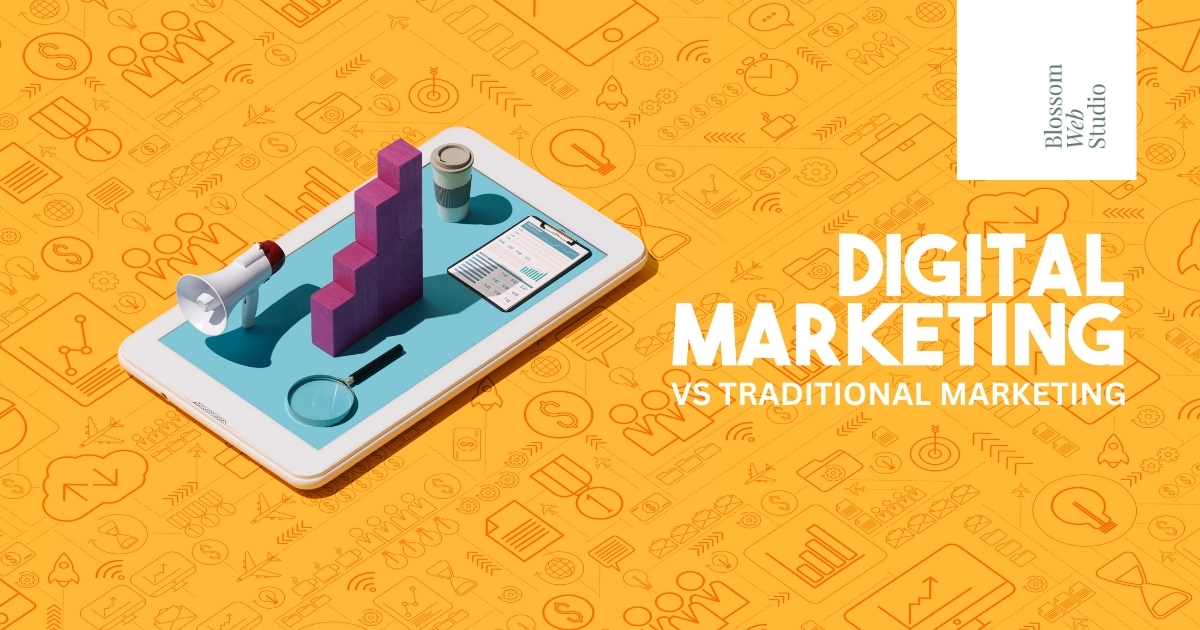
Digital Marketing vs. Traditional Marketing: What’s the difference?
Marketing has always been a cornerstone of business strategy, essential for reaching potential customers and building brand recognition.

However, with the advent of the internet and digital technologies, the landscape of marketing has transformed dramatically. This transformation has led to the rise of digital marketing, which contrasts sharply with traditional marketing methods. To understand these differences more comprehensively, let’s delve into the core aspects of both digital and traditional marketing, examining their definitions, strategies, benefits, and challenges.
Understanding Traditional Marketing
Traditional marketing encompasses conventional methods of promotion and communication that have been used for decades. This category includes:
Print Advertising: Newspapers, magazines, brochures, and flyers fall into this category. These materials often provide detailed information about products or services and are distributed in physical formats.
Broadcast Media: Television and radio advertisements are powerful tools for reaching broad audiences. TV ads often involve high production costs but can generate significant visibility and impact.
Outdoor Advertising: Billboards, transit ads, and posters are included here. They are strategically placed in high-traffic areas to capture the attention of passersby.
Direct Mail: This involves sending physical promotional materials like postcards, catalogs, and coupons directly to consumers’ mailboxes.
Telemarketing: This method uses phone calls to contact potential customers directly, offering products or services and gathering feedback.
Benefits of Traditional Marketing
Broad Reach: Traditional media channels, such as television and radio, can reach large audiences simultaneously.
Tangible Materials: Print materials provide a physical touchpoint, which can be particularly memorable.
Local Focus: Traditional marketing can be highly effective for localized campaigns, especially with direct mail and local newspapers.
Challenges of Traditional Marketing
High Costs: Producing and distributing traditional media can be expensive, often requiring significant financial investment.
Limited Metrics: Measuring the effectiveness of traditional marketing campaigns can be difficult and imprecise.
Static: Once a campaign is launched, making changes is challenging and costly.
Understanding Digital Marketing
Digital marketing leverages online platforms and technologies to promote products and services. Key components include:
Search Engine Optimization (SEO): This involves optimizing a website’s content and structure to improve its visibility in search engine results pages (SERPs), driving organic traffic.
Content Marketing: Creating valuable and relevant content—such as blogs, videos, and infographics—to attract and engage a target audience.
Social Media Marketing: Using platforms like Facebook, Instagram, Twitter, and LinkedIn to reach and interact with users, build brand awareness, and drive engagement.
Email Marketing: Sending targeted emails to subscribers to promote products, offer discounts, or provide valuable content.
Pay-Per-Click Advertising (PPC): Running ads on search engines or social media where advertisers pay each time their ad is clicked. Google Ads and Facebook Ads are prominent examples.
Affiliate Marketing: Collaborating with affiliates who promote your products or services in exchange for a commission on sales generated through their referral links.
Benefits of Digital Marketing
Cost-Effectiveness: Many digital marketing strategies are more affordable compared to traditional methods, particularly for small businesses.
Targeted Reach: Digital marketing allows for precise targeting based on demographics, interests, and behavior, increasing the relevance of campaigns.
Measurable Results: Tools like Google Analytics and social media insights provide detailed metrics on campaign performance, enabling real-time adjustments.
Interactivity: Digital platforms enable direct interaction with consumers, fostering engagement and building relationships.
Challenges of Digital Marketing
Highly Competitive: The digital space is crowded, making it challenging to stand out and capture attention.
Rapid Changes: The digital landscape evolves quickly, requiring marketers to stay updated with the latest trends and technologies.
Data Privacy Concerns: With increased data collection comes the need for stringent privacy practices to maintain consumer trust.
Comparing Digital and Traditional Marketing
Reach and Audience Engagement: Traditional marketing offers broad reach through mass media but lacks the precision of digital marketing. Digital marketing excels in targeting specific audiences and fostering engagement through interactive content and social media.
Cost and Budgeting: Traditional marketing can be expensive, especially with large-scale campaigns. Digital marketing, on the other hand, often provides more budget-friendly options and better scalability, allowing for adjustments based on performance.
Measurement and Analytics: Digital marketing benefits from advanced analytics tools that offer insights into campaign performance, user behavior, and ROI. Traditional marketing lacks such granular measurement capabilities, making it harder to gauge effectiveness accurately.
Flexibility and Adaptability: Digital marketing campaigns can be modified in real-time based on performance data, while traditional marketing campaigns are generally fixed once launched, with changes being costly and cumbersome.
Consumer Interaction: Digital marketing fosters two-way communication, enabling direct feedback and interaction with consumers. Traditional marketing typically involves a one-way communication channel, with limited opportunities for immediate interaction.
Integrating Digital and Traditional Marketing
Many successful businesses use a combination of both digital and traditional marketing to maximize their reach and effectiveness. This integrated approach allows for:
Cross-Channel Promotion: Using traditional methods to drive traffic to digital platforms and vice versa.
Enhanced Brand Consistency: Maintaining a cohesive brand message across multiple channels ensures a unified customer experience.
Optimized Resource Allocation: Leveraging the strengths of each approach to achieve a balanced and effective marketing strategy.
Conclusion
Both digital and traditional marketing have distinct advantages and challenges. Traditional marketing offers broad reach and tangible materials but comes with higher costs and less precise measurement. Digital marketing, conversely, provides targeted reach, cost-effectiveness, and detailed analytics but operates in a highly competitive and rapidly evolving environment. Understanding these differences enables businesses to tailor their marketing strategies effectively, often combining both approaches to leverage their unique strengths and achieve optimal results. In today’s dynamic market, a well-rounded marketing strategy that integrates both digital and traditional elements can be the key to success.



 Let's Chat on WhatsApp
Let's Chat on WhatsApp